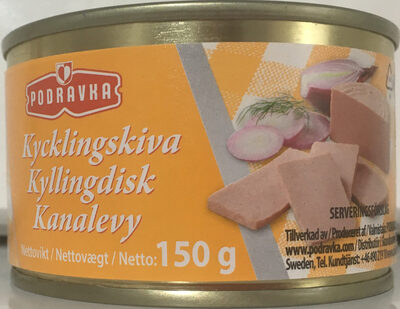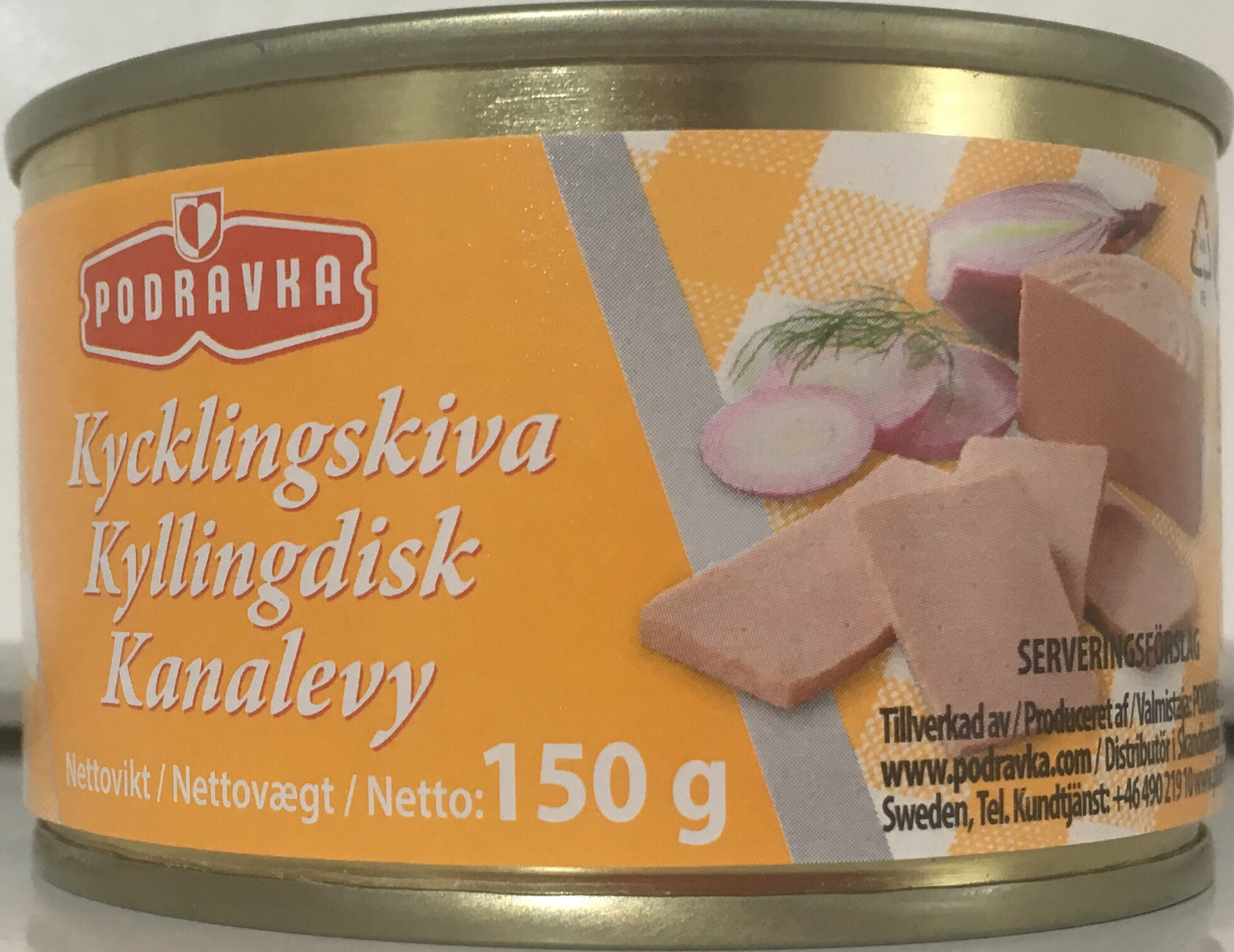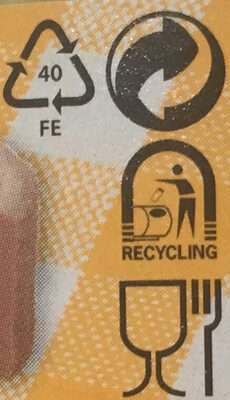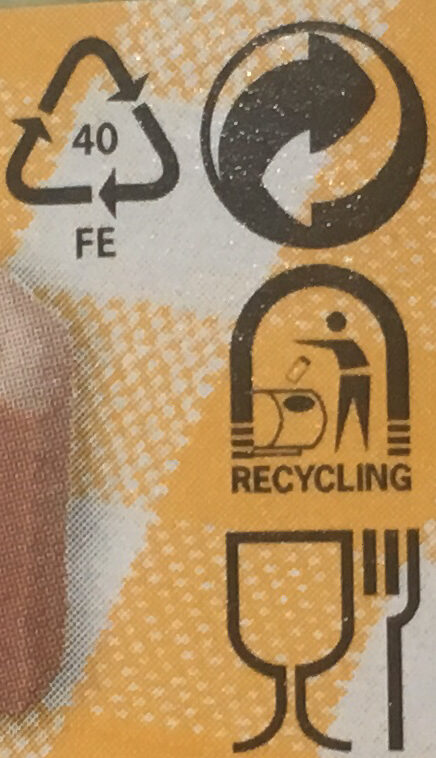Hjelp oss med å gjøre åpenhet om mat til det normale!
Som en ideell organisasjon, er vi avhengige av dine donasjoner for å fortsette å informere forbrukere verden over om hva de spiser.
Matrevolusjonen starter med deg!
Kyllingdisk - Podravka - 150g
Kyllingdisk - Podravka - 150g
Denne produktsiden er ikke fullstendig. Du kan hjelpe med å ferdigstille den ved å redigere den og legge til mere data fra bildene vi har, eller ved å ta flere bilder i appen for Android eller iPhone/iPad. Takk!
×
Strekkode: 3850104055706 (EAN / EAN-13)
Mengde: 150g
Emballasje: en:Metal, en:Recyclable Metals, 41 ALU, en:Can
Merker: Podravka
Kategorier: en:Meats and their products, en:Meats, en:Chicken and its products, en:Poultries, Høns
Etiketter, sertifiseringer, priser:
Grønt Punkt
Produksjon- eller behandlingssteder: Hungary
Sporbarhetskode: HR 139 EU
Samsvarer med dine preferanser
Helse
Ingredienser
-
24 ingredienser
Mekanisk utbeinet kyllingkjøtt (50%), vann, kyllingkjøtt (10%), vegetabilsk fett (palmefett, palmeolje), maisstivelse, soyaprotein, salt, krydder, krydderekstrakter, stabilisator (E450, E451), sukkerarter, surhetsregulerende middel (E575), antioksidanter (E316), smaksforsterker (E621), aromaer, konserveringsmidler (E250). Kan inneholde hvete, egg, melk og selleri.Allergener: Soya, SoyaproteinSpor: Selleri, Egg, Gluten, Melk
Matprosessering
-
Ultrabearbeidede matvarer
Elementer som indikerer at produkter er i en:4 - Ultra processed food and drink products-gruppen:
- Tilsetningsstoff: E450 - Difosfater
- Tilsetningsstoff: E451 - Trifosfater
- Tilsetningsstoff: E621 - Natriumglutamat
- Ingrediens: Smaksforsterker
- Ingrediens: Aroma
Matvarer er inndelt i 4 grupper i henhold til bearbeidingsgraden:
- Ubearbeidet eller minimalt bearbeidet mat
- Bearbeidede kulinariske ingredienser
- Bearbeidet mat
- Ultrabearbeidede matvarer
Bestemmelsen av gruppa er basert på kategorien til produktet og på ingrediensene den inneholder.
Tilsetningsstoffer
-
E250 - Natriumnitritt
Sodium nitrite: Sodium nitrite is the inorganic compound with the chemical formula NaNO2. It is a white to slightly yellowish crystalline powder that is very soluble in water and is hygroscopic. It is a useful precursor to a variety of organic compounds, such as pharmaceuticals, dyes, and pesticides, but it is probably best known as a food additive to prevent botulism. It is on the World Health Organization's List of Essential Medicines, the most important medications needed in a basic health system.Nitrate or nitrite -ingested- under conditions that result in endogenous nitrosation has been classified as "probably carcinogenic to humans" by International Agency for Research on Cancer -IARC-.Kilde: Wikipedia (Engelsk)
-
E316
Sodium erythorbate: Sodium erythorbate -C6H7NaO6- is a food additive used predominantly in meats, poultry, and soft drinks. Chemically, it is the sodium salt of erythorbic acid. When used in processed meat such as hot dogs and beef sticks, it increases the rate at which nitrite reduces to nitric oxide, thus facilitating a faster cure and retaining the pink coloring. As an antioxidant structurally related to vitamin C, it helps improve flavor stability and prevents the formation of carcinogenic nitrosamines. When used as a food additive, its E number is E316. The use of erythorbic acid and sodium erythorbate as a food preservative has increased greatly since the U.S. Food and Drug Administration banned the use of sulfites as preservatives in foods intended to be eaten fresh -such as ingredients for fresh salads- and as food processors have responded to the fact that some people are allergic to sulfites. It can also be found in bologna, and is occasionally used in beverages, baked goods, and potato salad.Sodium erythorbate is produced from sugars derived from different sources, such as beets, sugar cane, and corn. An urban myth claims that sodium erythorbate is made from ground earthworms; however, there is no truth to the myth. It is thought that the genesis of the legend comes from the similarity of the chemical name to the words earthworm and bait.Alternative applications include the development of additives that could be utilized as anti-oxidants in general. For instance, this substance has been implemented in the development of corrosion inhibitors for metals and it has been implemented in active packaging.Sodium erythorbate is soluble in water. The pH of the aqueous solution of the sodium salt is between 5 and 6. A 10% solution, made from commercial grade sodium erythorbate, may have a pH of 7.2 to 7.9. In its dry, crystalline state it is nonreactive. But, when in solution with water it readily reacts with atmospheric oxygen and other oxidizing agents, which makes it a valuable antioxidant.Kilde: Wikipedia (Engelsk)
-
E451 - Trifosfater
Sodium triphosphate: Sodium triphosphate -STP-, also sodium tripolyphosphate -STPP-, or tripolyphosphate -TPP-,- is an inorganic compound with formula Na5P3O10. It is the sodium salt of the polyphosphate penta-anion, which is the conjugate base of triphosphoric acid. It is produced on a large scale as a component of many domestic and industrial products, especially detergents. Environmental problems associated with eutrophication are attributed to its widespread use.Kilde: Wikipedia (Engelsk)
-
E575 - Glukonsyrans deltalakton
Glucono delta-lactone: Glucono delta-lactone -GDL-, also known as gluconolactone, is a food additive with the E number E575 used as a sequestrant, an acidifier, or a curing, pickling, or leavening agent. It is a lactone of D-gluconic acid. Pure GDL is a white odorless crystalline powder. GDL has been marketed for use in feta cheese. GDL is neutral, but hydrolyses in water to gluconic acid which is acidic, adding a tangy taste to foods, though it has roughly a third of the sourness of citric acid. It is metabolized to 6-phospho-D-gluconate; one gram of GDL yields roughly the same amount of metabolic energy as one gram of sugar. Upon addition to water, GDL is partially hydrolysed to gluconic acid, with the balance between the lactone form and the acid form established as a chemical equilibrium. The rate of hydrolysis of GDL is increased by heat and high pH.The yeast Saccharomyces bulderi can be used to ferment gluconolactone to ethanol and carbon dioxide. The pH value greatly affects culture growth. Gluconolactone at 1 or 2% in a mineral media solution causes the pH to drop below 3.It is also a complete inhibitor of the enzyme amygdalin beta-glucosidase at concentrations of 1 mM.Kilde: Wikipedia (Engelsk)
-
E621 - Natriumglutamat
Monosodium glutamate: Monosodium glutamate -MSG, also known as sodium glutamate- is the sodium salt of glutamic acid, one of the most abundant naturally occurring non-essential amino acids. Glutamic acid is found naturally in tomatoes, grapes, cheese, mushrooms and other foods.MSG is used in the food industry as a flavor enhancer with an umami taste that intensifies the meaty, savory flavor of food, as naturally occurring glutamate does in foods such as stews and meat soups. It was first prepared in 1908 by Japanese biochemist Kikunae Ikeda, who was trying to isolate and duplicate the savory taste of kombu, an edible seaweed used as a base for many Japanese soups. MSG as a flavor enhancer balances, blends, and rounds the perception of other tastes.The U.S. Food and Drug Administration has given MSG its generally recognized as safe -GRAS- designation. A popular belief is that large doses of MSG can cause headaches and other feelings of discomfort, known as "Chinese restaurant syndrome," but double-blind tests fail to find evidence of such a reaction. The European Union classifies it as a food additive permitted in certain foods and subject to quantitative limits. MSG has the HS code 29224220 and the E number E621.Kilde: Wikipedia (Engelsk)
Analyse av ingredienser:
-
en:Palm oil
Ingredienser som inneholder palmeolje: Palmefett, Palmeolje
-
en:Non-vegan
Ikke-veganske ingredienser: KyllingkjøttNoen ingredienser kunne ikke gjenkjennes.
Vi trenger din hjelp!
Du kan hjelpe oss med å gjenkjenne flere ingredienser og bedre analysere ingredienslista for dette produktet og andre ved å:
- Rediger denne produktsiden for å korrigere skrivefeil i ingredienslista, og/eller for å fjerne ingredienser på andre språk og setninger som ikke er knyttet til ingrediensene.
- Legg inn nye oppføringer, synonymer eller oversettelser til våre flerspråklige ingredienslister, ingrediensbearbeidingsmetoder, og etiketter.
Bli med i kanalen #ingredients på vårt Slack-samtalested og/eller lære om ingrediensanalyse på wikien vår, hvis du ønsker å hjelpe til. Tusen takk!
-
en:Non-vegetarian
Ikke-vegetarianske ingredienser: KyllingkjøttNoen ingredienser kunne ikke gjenkjennes.
Vi trenger din hjelp!
Du kan hjelpe oss med å gjenkjenne flere ingredienser og bedre analysere ingredienslista for dette produktet og andre ved å:
- Rediger denne produktsiden for å korrigere skrivefeil i ingredienslista, og/eller for å fjerne ingredienser på andre språk og setninger som ikke er knyttet til ingrediensene.
- Legg inn nye oppføringer, synonymer eller oversettelser til våre flerspråklige ingredienslister, ingrediensbearbeidingsmetoder, og etiketter.
Bli med i kanalen #ingredients på vårt Slack-samtalested og/eller lære om ingrediensanalyse på wikien vår, hvis du ønsker å hjelpe til. Tusen takk!
-
Detaljer fra analysen av ingrediensene
Vi trenger din hjelp!
Noen ingredienser kunne ikke gjenkjennes.
Vi trenger din hjelp!
Du kan hjelpe oss med å gjenkjenne flere ingredienser og bedre analysere ingredienslista for dette produktet og andre ved å:
- Rediger denne produktsiden for å korrigere skrivefeil i ingredienslista, og/eller for å fjerne ingredienser på andre språk og setninger som ikke er knyttet til ingrediensene.
- Legg inn nye oppføringer, synonymer eller oversettelser til våre flerspråklige ingredienslister, ingrediensbearbeidingsmetoder, og etiketter.
Bli med i kanalen #ingredients på vårt Slack-samtalested og/eller lære om ingrediensanalyse på wikien vår, hvis du ønsker å hjelpe til. Tusen takk!
: Mekanisk utbeinet kyllingkjøtt 50%, vann, kyllingkjøtt 10%, vegetabilsk fett (palmefett, palmeolje), maisstivelse, _soyaprotein_, salt, krydder, krydderekstrakter, stabilisator (e450, e451), sukkerarter, surhetsregulerende middel (e575), antioksidanter (e316), smaksforsterker (e621), aromaer, konserveringsmidler (e250)- Mekanisk utbeinet kyllingkjøtt -> nb:mekanisk-utbeinet-kyllingkjøtt - percent_min: 50 - percent: 50 - percent_max: 50
- vann -> en:water - vegan: yes - vegetarian: yes - ciqual_food_code: 18066 - percent_min: 10 - percent_max: 40
- kyllingkjøtt -> en:chicken-meat - vegan: no - vegetarian: no - ciqual_food_code: 36005 - percent_min: 10 - percent: 10 - percent_max: 10
- vegetabilsk fett -> en:vegetable-fat - vegan: yes - vegetarian: yes - from_palm_oil: maybe - percent_min: 0 - percent_max: 10
- palmefett -> en:palm-fat - vegan: yes - vegetarian: yes - from_palm_oil: yes - ciqual_proxy_food_code: 16129 - percent_min: 0 - percent_max: 10
- palmeolje -> en:palm-oil - vegan: yes - vegetarian: yes - from_palm_oil: yes - ciqual_food_code: 16129 - percent_min: 0 - percent_max: 5
- maisstivelse -> en:corn-starch - vegan: yes - vegetarian: yes - ciqual_food_code: 9510 - percent_min: 0 - percent_max: 10
- _soyaprotein_ -> nb:soyaprotein - percent_min: 0 - percent_max: 10
- salt -> en:salt - vegan: yes - vegetarian: yes - ciqual_food_code: 11058 - percent_min: 0 - percent_max: 1.6
- krydder -> en:spice - vegan: yes - vegetarian: yes - percent_min: 0 - percent_max: 1.6
- krydderekstrakter -> en:herb-extract - vegan: yes - vegetarian: yes - percent_min: 0 - percent_max: 1.6
- stabilisator -> en:stabiliser - percent_min: 0 - percent_max: 1.6
- e450 -> en:e450 - vegan: yes - vegetarian: yes - percent_min: 0 - percent_max: 1.6
- e451 -> en:e451 - vegan: yes - vegetarian: yes - percent_min: 0 - percent_max: 0.8
- sukkerarter -> nb:sukkerarter - percent_min: 0 - percent_max: 1.6
- surhetsregulerende middel -> en:acidity-regulator - percent_min: 0 - percent_max: 1.6
- e575 -> en:e575 - vegan: yes - vegetarian: yes - percent_min: 0 - percent_max: 1.6
- antioksidanter -> nb:antioksidanter - percent_min: 0 - percent_max: 1.6
- e316 -> en:e316 - vegan: yes - vegetarian: yes - percent_min: 0 - percent_max: 1.6
- smaksforsterker -> en:flavour-enhancer - percent_min: 0 - percent_max: 1.6
- e621 -> en:e621 - vegan: yes - vegetarian: yes - percent_min: 0 - percent_max: 1.6
- aromaer -> en:flavouring - vegan: maybe - vegetarian: maybe - percent_min: 0 - percent_max: 1.6
- konserveringsmidler -> en:preservative - percent_min: 0 - percent_max: 1.6
- e250 -> en:e250 - vegan: yes - vegetarian: yes - percent_min: 0 - percent_max: 1.6
Ernæring
-
Svak ernæringskvalitet
⚠ ️Advarsel: mengden fiberer ikke spesifisert, deres mulige positive bidrag til karakteren kunne ikke tas med i betraktningen.⚠ ️Advarsel: mengden frukt, grønnsaker og nøtter er ikke spesifisert på etiketten, den ble anslått utfra ingredienslista: 0Dette produktet regnes ikke som en drikke under beregningen av Nutri-Score.
Positive poeng: 0
- Protein: 5 / 5 (verdi: 11, avrundet verdi: 11)
- Fiber: 0 / 5 (verdi: 0, avrundet verdi: 0)
- Frukt, grønnsaker, nøtter, og raps/valnøtt/olivenoljer: 0 / 5 (verdi: 0, avrundet verdi: 0)
Negative poeng: 14
- Energi: 2 / 10 (verdi: 921, avrundet verdi: 921)
- Sukker: 0 / 10 (verdi: 0.2, avrundet verdi: 0.2)
- Mettet fett: 5 / 10 (verdi: 5.7, avrundet verdi: 5.7)
- Natrium: 7 / 10 (verdi: 640, avrundet verdi: 640)
Poengene for proteiner telles ikke fordi de negative poengene er større eller lik 11.
Ernæringsverdi: (14 - 0)
Nutri-Score:
-
Næringsnivåer
-
Fett i moderat mengde (17%)
Fint å vite- Et høyt inntak av fett, spesielt mettet fett, kan øke kolesterolet, som øker risikoen for hjertesjukdommer.
Anbefaling: Reduser inntaket av fett og mettet fett- Velg produkter med lavere fett- og mettet fettinnhold.
-
Mettet fett i høy kvantitet (5.7%)
Fint å vite- Et høyt inntak av fett, spesielt mettet fett, kan øke kolesterolet, som øker risikoen for hjertesjukdommer.
Anbefaling: Reduser inntaket av fett og mettet fett- Velg produkter med lavere fett- og mettet fettinnhold.
-
Sukkerarter i liten kvantitet (0.2%)
Fint å vite- Et høyt inntak av sukker kan føre til økning i vekt og tannråte. Det øker også risikoen for diabetes type 2 og hjerte- og karsjukdommer.
Anbefaling: Begrens inntaket av sukker og sukkerholdige drikker- Sukkerholdige drikker (som brus, fruktdrikker, og fruktjuicer og nektar) burde begrenses så mye som mulig (ikke mer enn 1 glass om dagen).
- Velg produkter med lavt sukkerinnhold og reduser inntaket av produkter med tilsatt sukker.
-
Salt i høy kvantitet (1.6%)
Fint å vite- Et høyt inntak av salt (eller sodium) kan føre til et økt blodtrykk, som kan føre til høyere risiko for hjertesjukdom og slag.
- Mange folk har høyt blodtrykk uten å vite det, siden det ofte ikke er noen symptomer.
- De fleste inntar for mye salt (i gjennomsnitt 9 til 12 gram per dag), cirka det dobbelte av den anbefalte høyeste mengden av inntak.
Anbefaling: Begrens inntaket av salt og saltet mat- Reduser mengden salt som brukes ved matlaging, og ikke salt igjen ved bordet.
- Begrens inntaket av salte snacks og velg produkter med lavere saltinnhold.
-
-
Ernæringsinnhold
Ernæringsinnhold Som solgt
for 100 g / 100 mlSammenlignet med: Høns Energi 921 kj
(222 kcal)+39 % Fett 17 g +117 % Mettet fett 5,7 g +182 % Karbohydrat 6,2 g +90 % Sukkerarter 0,2 g −50 % Kostfiber ? Protein 11 g −39 % Salt 1,6 g +37 % Fruits‚ vegetables‚ nuts and rapeseed‚ walnut and olive oils (estimate from ingredients list analysis) 0 %
Miljø
-
Eco-Score E - Veldig høyt miljøavtrykk
Eco-Scoren er en eksperimentell poengsum som oppsummerer miljøavtrykket til matprodukter.→ Eco-Scoren ble opprinnelig utviklet for Frankrike og den blir nå utvidet til andre europeiske land. Eco-Score-formelen er i stadig endring og forbedres jevnlig for å gjøre den mer presis og bedre egnet til hvert land.Livssyklusanalyse
-
Gjennomsnittlig avtrykk for produkter i samme kategori: C (Score: 41/100)
Kategori: Chicken, meat and skin, raw
Kategori: Chicken, meat and skin, raw
- PEF-miljøscore: 0.71 (jo lavere poengsum, jo lavere avtrykk)
- inkludert innvirkning på klimaendringer: 5.52 kg CO2-ekv./kg produkt
Trinn Påvirkning Landbruk
82.8 %Bearbeiding
10.5 %Emballasje
2.5 %Transport
2.6 %Distribusjon
1.3 %Forbruk
0.3 %
Fordeler og ulemper
-
Mangler ingrediensopprinnelsesinformasjon
Ulempe: -5
⚠ ️ Opprinnelsen til ingrediensene til produktet er ikke angitt.
Hvis det er indikert på emballasjen, kan du redigere produktsiden og legge det til.
Hvis du er produsenten av produktet, kan du sende oss informasjon gjennom vår gratis plattform for produsenter.
-
Ingredienser som truer arter
Ulempe: -10
Inneholder palmeolje
Tropiske skoger i Asia, Afrika og Latin-Amerika ødelegges for å lage og utvide plantasjoner for palmeoljeproduksjon. Avskogingen bidrar til klimaendringer, og truer arter som orangutangen, dvergflodhesten og sumatraneshornet.
-
Emballasje med moderat avtrykk
Ulempe: -11
Form Material Resirkulering Påvirkning 1 Food can Metal Recycle in glass bin Høy 1 Label 22 PAP Recycle in glass bin Lav 1 Seal Metal Recycle in glass bin Høy ⚠ ️ Informasjonen om emballasjen til dette produktet er ikke tilstrekkelig presis (eksakte former og materialer av alle komponenter i emballasjen).⚠ ️ For en mer presis beregning av Eco-Scoren, kan du modifisere produktsiden og legge dem til.
Hvis du er produsenten av produktet, kan du sende oss informasjon gjennom vår gratis plattform for produsenter.
Eco-Score for dette produktet
-
Avtrykk for dette produktet: E (Score: 15/100)
Produkt: Kyllingdisk - Podravka - 150g
Livssyklusanalysescore: 41
Sum av fordeler og ulemper: -26
Endelig poengsum: 15/100
-
Carbon footprint
-
Likt som å kjøre 2.9 km i en bensinbil
552 g CO² per 100g produkt
Karbonutslippstallet kommer fra ADEME's Agribalyse database, for kategorien: Chicken, meat and skin, raw (Kilde: Ademe Agribalyse Database)
Trinn Påvirkning Landbruk
75.1 %Bearbeiding
14.9 %Emballasje
5.0 %Transport
4.2 %Distribusjon
0.7 %Forbruk
0.1 %
Emballasje
-
Emballasje med moderat avtrykk
-
Emballasjedeler
1 x Food can (Metal: 26.6 g)
1 x Label (22 PAP: 1 g)
1 x Seal (Metal: 7.3 g)
-
Emballasjematerialer
Material % Emballasjevekt Emballasjevekt per 100 g produkt Paper or cardboard 2.9% 1 g 0.7 g Metal 97.1% 33.9 g 22.6 g Total 100% 34.9 g 23.3 g
-
Transport
-
Opprinnelsen til ingredienser
Mangler ingrediensopprinnelsesinformasjon
⚠ ️ Opprinnelsen til ingrediensene til produktet er ikke angitt.
Hvis det er indikert på emballasjen, kan du redigere produktsiden og legge det til.
Hvis du er produsenten av produktet, kan du sende oss informasjon gjennom vår gratis plattform for produsenter.Legg til opprinnelsen til ingrediensene i dette produktet Legg til opprinnelsen til ingrediensene i dette produktet
Threatened species
-
Inneholder palmeolje
Fører til avskoging og truer arter som orangutangen
Tropiske skoger i Asia, Afrika og Latin-Amerika ødelegges for å lage og utvide plantasjoner for palmeoljeproduksjon. Avskogingen bidrar til klimaendringer, og truer arter som orangutangen, dvergflodhesten og sumatraneshornet.
Report a problem
-
Incomplete or incorrect information?
Category, labels, ingredients, allergens, nutritional information, photos etc.
If the information does not match the information on the packaging, please complete or correct it. Open Food Facts is a collaborative database, and every contribution is useful for all.
Datakilder
Produkt lagt til av kiliweb
Siste redigering av produktsiden den av odinh.
Produktside også redigert av halal-app-chakib, yuka.sY2b0xO6T85zoF3NwEKvllFtCIqPnhTZCxL5iV2v4f2HK77Yf-Bs3LChGao.













